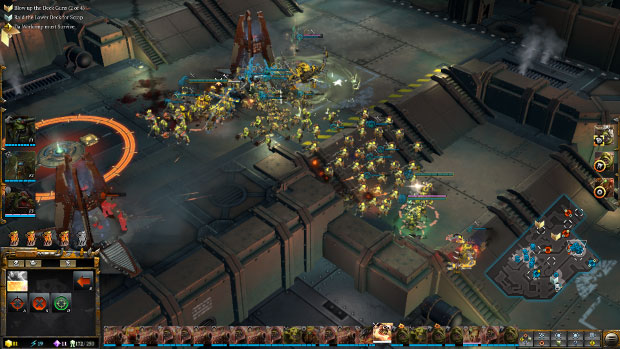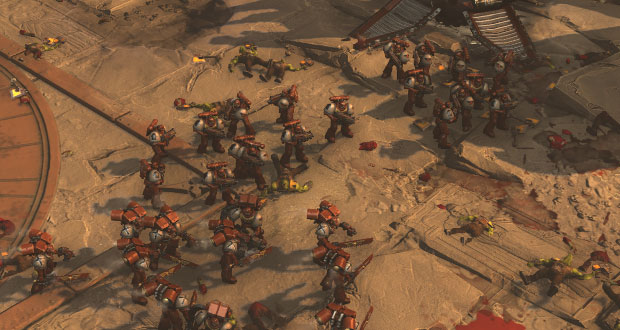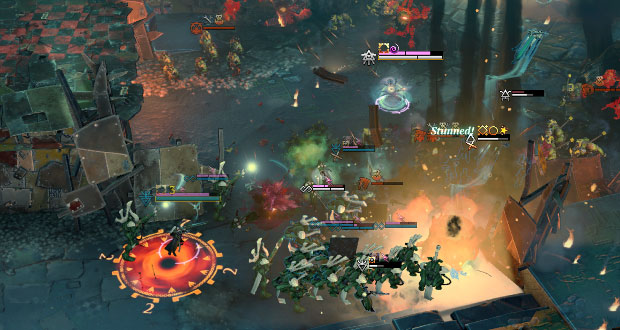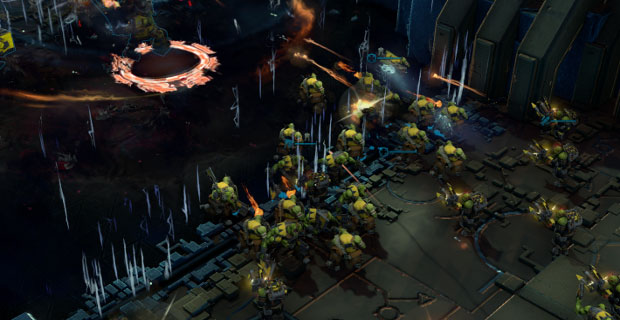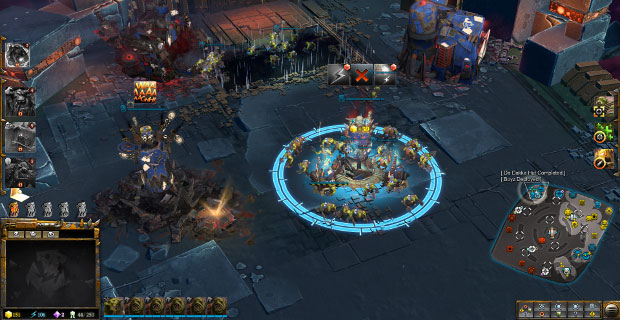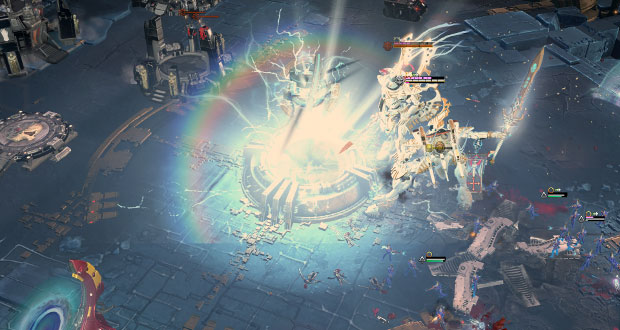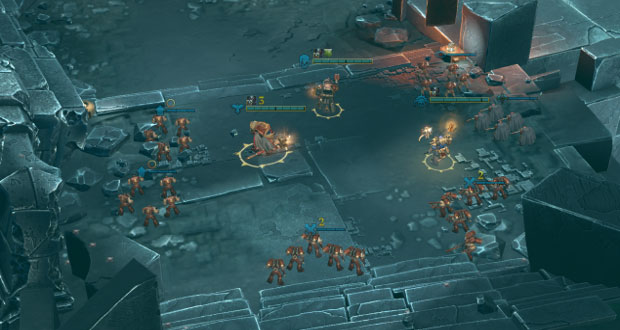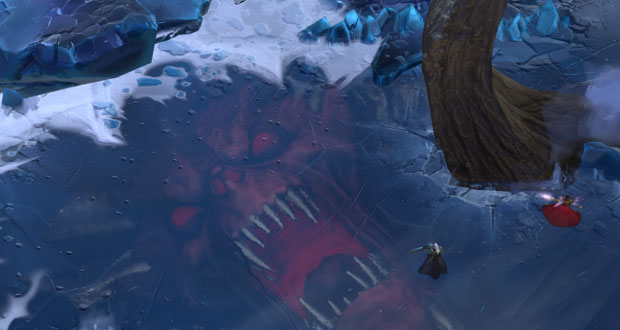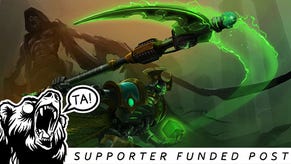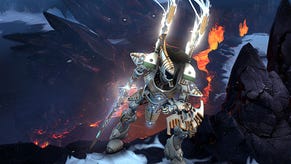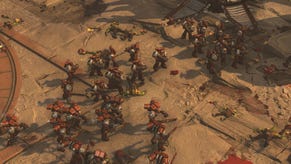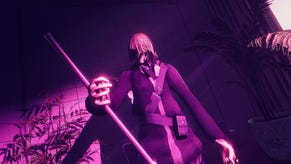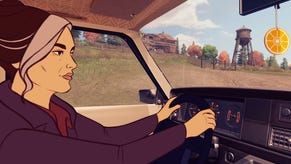Wot I Think: Warhammer 40,000 - Dawn of War 3
The Emperor will be mostly pleased
Warhammer 40,000: Dawn of War 3 [official site] wants to be everything you like about the series, and its very different predecessors, in a single RTS. Missed the big armies and the base building? They’re back. Prefer fighting with beefy heroic units with lots of special abilities? They’re here too. It’s trying to be all things to all men, women, Orks and Eldar, and crikey does it come close to succeeding. So close you can hear the heavy metal roar of an Ork Waaagh tower and the thudding of Space Marine boots.
For the first time, Relic have put all three of their favourite factions on equal footing straight away instead of holding all but the Space Marines back for expansions. The heavily armoured space fascists, Orks and Eldar share the spotlight in both the campaign and multiplayer – a relief after the spate of Space Marine-only affairs. And it’s in the design of these factions that Relic have done some of their strongest work.
Each group scratches an itch. The Emperor’s finest are like a fist smashing a face: punchy. They charge and leap with bolters blasting and swords held high, getting into brawls quickly and pinning down fleshy foes with big hammers and even bigger knockbacks. They’re as subtle as a fart in an elevator, as evidenced by their special ability: they can queue up drop pods, containing more Space Marines, primed to be dropped right on the heads of their foes.
The Eldar and Orks aren’t quite as intuitive, but benefit from an additional layer of complexity. The former, along with their speed and predilection for fast, ranged strikes, can link up buildings to create a web of teleporters, and even teleport the buildings themselves. They’re perfect for hit-and-run tactics and surprise assaults. Their green enemies, on the other hand, overwhelm with numbers and the power of their psychic rage - the Waaagh. They grow in strength as they loot and salvage scrap to be used for upgrades, new vehicles and additional Waaagh towers.
While all three factions feature a broad range of line units, from melee units that can lock down enemies to ranged troops who fire devastating weapons that need time to set up, they still feel fundamentally different. Here's an example of Marine combat.
Gabriel Angelos and a couple of squads of Tactical Marines are surrounded by pumped-up Orks, roaring and flailing with their cruel axes. They’re outnumbered, health rapidly being whittled down, and they can’t make it back to their base. Angelos, an Elite and thus blessed with more health and a suite of handy abilities, could make a break for it. He could leap over the Orks and leg it to safety, leaving his men behind. Instead, he leaps up, not over, and when he lands in the centre of the green tide, every enemy in the area flies backwards.
With extra breathing room, Angelos’ troops open fire, but they’re quickly forced back into desperate melee duels by another wave of enemies – enemies too busy to watch the skies. A roaring noise competes with the din of battle followed by, seconds later, two explosions. Two more rings of Orks are flung backwards. The drop pod doors open up with fresh soldiers pouring out, setting up firing positions and chasing down fleeing Nobz and Boyz.
Swap out the Space Marines for Eldar and the story changes. With their speed and penchant for slowing enemies, they really shouldn’t be surrounded in the first place, but if they are, they’re in a bit of a pickle. A whole jar of pickles. Eldar have a lot of strengths, but sustained melee engagements ain’t one of them – they crumble faster than me after a brisk jog, which is to say very quickly and with no small amount of embarrassment. Still, there are ways for them to escape using clouds of smoke and handy stuns, but if they choose to duke it out with the Orks, they won’t come out of it nearly as well as Angelos and his buds.
Some people will scoff at the idea that MOBAs can teach RTS games anything, but the MOBA inspiration behind unit design and ability synergy is a massive boon here. Though not quite as developed as the heroes from the likes of Dota or Heroes of the Storm, every unit – not just the Elites – has a hook and an ability that make them a valuable part of a team. And this goes well beyond the rock, paper, scissors formula. The value of a unit is more fluid, more situational, and depends on the squads around them creating opportunities.
It would be lovely, though, if everyone could maybe die… less? Or at least at a slower rate. It’s a bit of a jump from the incredibly hardy but small squads of Dawn of War 2 to these considerably more vulnerable facsimiles. It’s hard to get invested in a unit when they could get wiped out in a few seconds. It’s almost like Space Marine armour is actually made out of polystyrene. Sure, it’s lighter, and it’s probably more comfortable, but is comfort worth dying over?
The scarcity of properly hardy soldiers is something I could perhaps live with if there were more ways to mitigate damage. Unfortunately, after experimenting with a cover system in DoW2, Relic have chucked it in the bin in favour of no cover system at all. There are capturable areas that provide a destructible shield, but there’s no guarantee that you’ll be fighting anywhere near one; nor is one bit of cover really going to stop a lot of your troops from being riddled with holes. I like the clarity of these defensible positions, but there’s no flexibility. The result is that a great number of fights are pitched battles in open areas.
Line of sight and high ground have an impact, and hidden units – either through an ability or an area that cloaks them – mean that sneak attacks and ambushes are perfectly viable tactics, so battles are never just a matter of smashing armies together, but there’s no real room for a defensive player. As well as a dearth of cover to hide behind, there are incredibly few fortification options and units aren’t capable of being garrisoned in buildings. This is especially strange when you consider the multiplayer mode, which involves protecting your team’s power core while trying to take out the opposition’s.
Everyone is on the offensive in multiplayer. You might, like I did at first, build up your forces, protect some important resource points, and keep an eye on your power core, but you won’t make many friends, and your allies will probably blame you for the loss. Maybe they’re assholes, but they might also be right. If you’re not constantly harassing the enemy, taking out their Elites, and generally getting up to mischief, then you’re probably not helping.
That’s not really the important bit, mind. Who cares what your team thinks? The real problem is that playing defensively is so incredibly, dreadfully, mind-numbingly dull. Got a couple of guys hiding behind some smoke? Placed someone in the magical shield bubble? Great, you’re pretty much done. Build some more units, I guess? So now you’re bored and you aren’t really helping.
That aside, Dawn of War 3’s multiplayer battles are still great. 3v3 in particular is a glorious mess of clashing armies and territorial punch-ups. Here’s the gist: two teams duke it out over their respective power cores, each placed at opposite ends of the map. To take out a power core, at least one of the turrets protecting it must be destroyed, and to take out a turret, you’ve got to take out the shield generator protecting it. And to keep the conflict going at all times, resource points dot the map and create new objectives for players to fight over.
With so many targets and an escalation system that increases resource generation and building health every 10 minutes, there’s an aggressive, relentless flow to these battles, and first blood is usually spilled within the first minute. With drop pods falling from the skies, buildings teleporting willy-nilly and giant Elite units slaughtering entire squads in seconds, it can be chaotic and sometimes hard to parse, but this chaos is also the source of some of the most exhilarating RTS brawls I’ve had the pleasure to win and lose.
While the constant attack, attack, attack might seem repetitive, there’s plenty of diversity when it comes to choosing how you’re going to be aggressive. See, before every multiplayer match, and to a lesser extent campaign mission, you choose a loadout – three MOBA-like Elites and six doctrines, essentially augments and buffs. These can dramatically change the tone of your forces, or shore up any gaps in their capabilities.
Orks aren’t very sneaky. They are too loud and, let’s face it, too smelly for stealth. But with the right combination of Elites and doctrines, they can be almost as sly as the Eldar. Zapnoggin’, for instance, can teleport groups of Orks into or out of trouble with his fancy Ork magic, while one of their doctrines allows them to hide underneath the scrap they normally use to unlock new weapons and armour, littering the battlefield with potential ambush sites.
Doctrines and Elites require skulls before they can be unlocked, however. You can earn a fair amount of currency from the campaign and keep earning it through multiplayer matches. I’m still not entirely convinced by the unnecessarily complicated system, however. You’ve got army doctrines that are, not surprisingly, army wide; presence doctrines, which only work if the Elite they’re connected to is present on the battlefield; and command doctrines that work when a specific Elite is in your loadout. Then you’ve got to take into account levels, because command doctrines can only be unlocked when an Elite reaches level 3, and when it hits level 8 that same doctrine can be unlocked as an army doctrine and… I’m losing you, I know I am.
I’m some 1,600 words into this Wot I Think and you’re probably starting to notice that I’ve been avoiding the campaign. Unfortunately this is not because I’ve been building up to Dawn of War 3’s best feature. Nothing about it works for me. Not the paper-thin characters, not the plodding story, not the endless journeys across maps that keep growing. There are a few individual missions that I’ve definitely clicked with, but as a whole, the campaign is...well, it's a disappointment. It’s the one place where Relic’s attempt to merge elements from the two earlier games doesn’t really work, and the juxtaposition of linear, scripted missions with base building is incredibly awkward, cursing many missions with a confusing pace.
They usually start out by limiting your army to a handful of squads and forcing you down a bunch of corridors, fighting your way from A to B. Without wrinkles like cover, suppression and resources, it feels more like Diablo than an RTS. Sometimes, that’s the entire mission. A few squads and an Elite, jogging from one end of the map to the other. The majority, however, let you start building a base during the second phase of the mission. That’s when things start to feel like a strategy romp again, with armies duking it out over capture points and assaulting each other’s HQs.
I’d still do terrible things for a more reactive campaign AI, mind you. It feels like enemies never really act unless the invisible director tells them to. When they attack, it’s because they’ve reached that point in the mission when they’re meant to try to take out your base. When fast patrols start scouting and hunting down your minions, it’s because it’s part of a secondary objective, not just something an enemy with common sense would do.
Aside from Homeworld, Relic’s best campaigns tend to be non-linear and based around capturing territory across one or more campaign maps – a simulation of actual warfare. It’s desperately needed here. Without it, there aren’t enough decisions for players to make. From start to finish, the campaign feels like you’re playing someone else’s story, not your own. And while decent RTS campaigns increasingly feel like my white whale, I can usually depend on Relic for something better.
There are moments, many of them, during multiplayer and AI skirmishes, where I’m absolutely certain that Dawn of War 3 is the best game in the series, even with its missteps when it comes to cover and fortifications. I could happily continue rambling on about the brilliant faction design or how I still squeal with glee every time I drop a gargantuan beast of an Elite like Imperial Knight Solaria into a fight – you haven’t lived until you’ve witnessed her impossibly huge guns turning an army of Orks into green-red paste. If you’re only interested in the campaign, however, then you’re unlikely to find as much to get enthused about.
Warhammer 40,000: Dawn of War 3 is out on April 27th.


